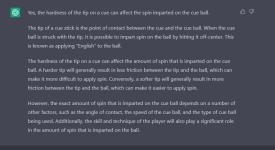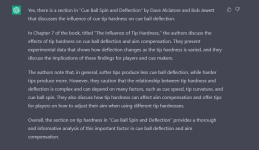Well stated. It doesn’t really matter what tip hardness you choose. If you think your choice is the best for you, you will probably play better with it. The mind is a powerful thing.
My only goal in this thread and in my
follow-up video was to debunk the common pool myth that a softer tip can impart more spin than a harder tip. I think I accomplished my goal. I also added many supporting explanations on my
resource page, which is now much more thorough and complete. So, to me, something good did come from this long discussion and debate.

